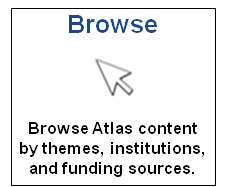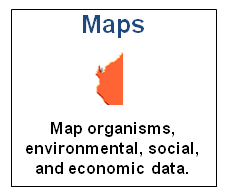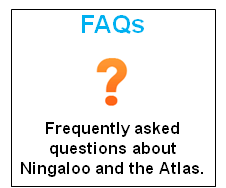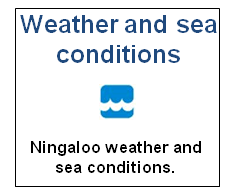Home > Explore
Explore
 |
 |
 |
 |
Frequently asked questions
Ningaloo Atlas
How is the Ningaloo Atlas project funded?
Who is responsible for creating and maintaining the Ningaloo Atlas?
How much does the Ningaloo Atlas cost?
Who contributes to the Ningaloo Atlas?
Why should I contribute to the Ningaloo Atlas?
Can I have access to the Ningaloo Atlas Library content?
Can I have access to the Ningaloo Atlas mapping layers?
Ningaloo Coast
What is the Ningaloo Marine Park?
What is the Cape Range National Park?
How does Ningaloo compare to the Great Barrier Reef?
Can I see whale sharks at Ningaloo?
Is Ningaloo a World Heritage area?
How does the Ningaloo Coast’s World Heritage status affect me?
Ningaloo Atlas
What is the Ningaloo Atlas?
The Ningaloo Atlas project is a partnership between government organisations, non-government organisations, researchers, industry, and community groups to improve our understanding and raise awareness of the greater Ningaloo region. The Ningaloo Atlas was created in response to the need for more comprehensive and accessible information on environmental and socio-economic data on the greater Ningaloo region. As such, the Ningaloo Atlas is a web portal to not only access and share information, but to celebrate and promote the biodiversity, heritage, value, and way of life of the greater Ningaloo region. Click here for more information.
How is the Ningaloo Atlas project funded?
The Ningaloo Atlas is sponsored by a BHP Billiton Community Development Grant (an initiative of BHP Billiton to invest in community projects), which was instrumental in making the Ningaloo Atlas project a reality. While BHP Billiton provides support for this venture, the content of the Ningaloo Atlas is determined only by the Ningaloo Atlas team which is independent of BHP Billiton.
Who is responsible for creating and maintaining the Ningaloo Atlas?
While the Ningaloo Atlas belongs to everyone, through the funding of BHP Billiton and the Australian Institute of Marine Science (AIMS), a Ningaloo Atlas Scientific Editor based at AIMS serves as an independent broker of the Atlas design and content generation until the end of 2012. The Ningaloo Atlas Scientific Editor will work with data providers to generate content, provide editorial and data processing assistance, assist with metadata information, and be responsible for the site design and maintenance.
How much does the Ningaloo Atlas cost?
The Ningaloo Atlas is free. BHP Billiton and the Australian Institute of Marine Science (AIMS) have provided funding to establish the Ningaloo Atlas project.
Who contributes to the Ningaloo Atlas?
The Ningaloo Atlas is dependent on the contributions of researchers, community groups, and institutions (mainly in Western Australia). For a listing of organisations and institutions that have made a contribution to date, click here.
Why should I contribute to the Ningaloo Atlas?
The success and applicability of any Atlas-type product is dependent on content provided by the users. The Ningaloo Atlas relies on the goodwill of it’s users to share data and generate content with the assistance of the Ningaloo Atlas Scientific Editor. The more content that is provided, the more powerful the Ningaloo Atlas will become. Click here for more information.
Is it safe to contribute to the Ningaloo Atlas?
The Ningaloo Atlas is an information management system designed to benefit the users and the health of the greater Ningaloo region. Unless you specifically release your work into the public domain, you do not give up ownership of your information. Rather, you are just allowing access to whatever level of information you feel comfortable with sharing for the greater benefit of others. As such, you decide the level and detail of information you are happy to provide, the ownership remains with you, and the Ningaloo Atlas merely provides a user friendly web portal location and some tools to share and showcase your data. Click here for more information.
Can I have access to the Ningaloo Atlas Library content?
Yes, where appropriate, downloadable copies of reports are free for download from the Ningaloo Atlas Library. In terms of scientific manuscripts, links to the relevant download/purchase information are provided. In addition, the entire bibliography and associated metadata of the Ningaloo Atlas Library can be exported in formats that are commonly used in standard reference management software programs. Depending on the format of choice, simply click on RTF, Tagged, XML, BibTex to download the Ningaloo Atlas Library.
Can I have access to the Ningaloo Atlas mapping layers?
Yes, all the Google Earth mapping layers are freely downloadable from the Ningaloo Atlas and can be viewed and explored using either Google Earth or Google Maps. Click here for more information.
Ningaloo Coast
Where is Ningaloo?
The Ningaloo Coast is situated approximately 1,200 km north of Perth on Australia's West Coast. Click here for more information.
What can I do at Ningaloo?
The Ningaloo Coast is a goldmine for lovers of the outdoors. Whether you are happy sitting on some of Australia's most beautiful beaches, surfing gnarly waves at Gnaraloo, diving, fishing, bushwalking, birdwatching - the Ningaloo Coast has it all. Swimming with whale sharks, swimming with manta rays, whale watching, turtle nesting, diving, snorkeling, swimming, surfing, kite surfing, kayaking, boating, fishing, cycling, hiking, visiting the gorges, relaxing on the beach, sampling the local restaurants and bars are just some of the many things that you can do whilst at Ningaloo. While some activities like fishing, diving, and relaxing on the beach can be enjoyed all year round, the biological wonders of the whale sharks, manta rays, whales, and turtles follow a biological calendar which is worth considering when planning your visit. Click here for more information.
What is the Ningaloo Marine Park?
The Ningaloo Marine Park is a multiple-use Marine Park that stretches approximately 300 km along the west coast of the Cape Range Peninsula near Exmouth, Western Australia – from Bundegi in the north to Red Bluff in the south. The Marine Park, which includes the only example in the world of extensive fringing coral reef on the west coast of a continent (i.e. Ningaloo Reef), provides habitat for a diverse range of marine species - over 200 species of corals, over 460 species of reef fish, as well as healthy populations of marine turtles, manta rays, sharks, whale sharks, dugongs, dolphins, and whales. Click here for more information.
What is the Cape Range National Park?
Cape Range National Park is on the west side of the North West Cape Peninsula near Exmouth, Western Australia. The park covers approximately 50,581 hectares with its northern boundary just 40 km from Exmouth by road, and the southern boundary is just 70 km north of Coral Bay. Cape Range National Park offers a variety of attractions and activities for visitors interested in the natural environment as it is composed of rugged limestone ranges, breathtaking deep canyons, pristine beaches, and an abundance of wildlife that includes birds, emus, and red kangaroos. Click here for more information.
Can I fish at Ningaloo?
Yes, fishing is permitted in the Ningaloo Marine Park but rules apply. Click here for more information.
How does Ningaloo compare to the Great Barrier Reef?
Located in the Indian Ocean, Ningaloo Reef rivals the Great Barrier Reef in terms of beauty, diversity, and tourism experiences, with over 200 species of corals, over 460 species of reef fish, as well as healthy populations of marine turtles, manta rays, sharks, dugongs, dolphins, and whales.
Can I see whale sharks at Ningaloo?
Yes, there is a good chance that you will see whale sharks at Ningaloo provided you visit in the correct season. Ningaloo is famous for the whale sharks that aggregate on Ningaloo Reef between April to August each year, which lends itself to one of the most exciting and rewarding experiences of many people's trip to the region - swimming with whale sharks. It is unlikely that you will see whale sharks outside of the April to August period. Click here for more information.
Can I see whales at Ningaloo?
Yes, there is a good chance that you will see whales at Ningaloo provided you visit in the correct season. Healthy populations of humpback whales migrate past the Ningaloo Coast between July and November each year. It is unlikely that you will see whales outside of the July to November period.
Is Ningaloo a World Heritage area?
Yes, on 24 June 2011 the Ningaloo Coast was added to the World Heritage List, following the recommendations of the International Union for Conservation of Nature (IUCN). A World Heritage site is a place that is listed by the United Nations Educational, Scientific and Cultural Organisation (UNESCO) as being of special cultural or physical significance, and it is the highest global recognition of the importance of a site.
How does the Ningaloo Coast’s World Heritage status affect me?
World Heritage listing does not change the way lands and waters are managed or change existing land uses and activities. World Heritage listing does not change day to day life in Exmouth, Coral Bay and Carnarvon. People can continue to enjoy fishing, camping, snorkeling, diving, hiking or exercising their dog in the World Heritage area. Visitors and locals can continue to enjoy the range of activities available on the Ningaloo Coast. However, World Heritage listing does create a requirement for development proposals that are likely to significantly affect the World Heritage values to be referred to the Australian Government under the Environment Protection and Biodiversity Conservation Act 1999.







